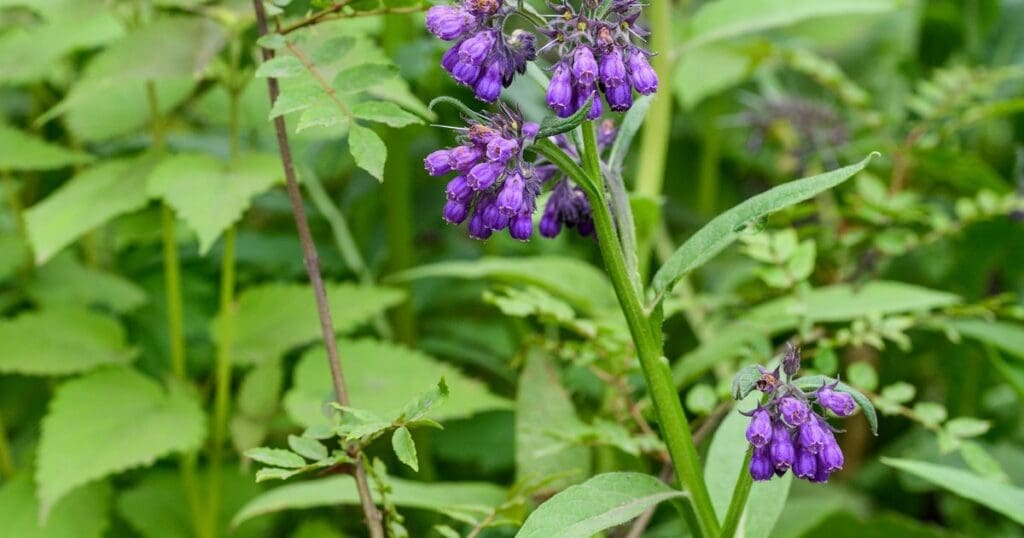
Symphytum officinale
Latin name: Symphytum officinale
Short name: Symph
Common name: Comfrey | Knitbone | Boneset | Healing Herb | Blackwort
Primary miasm: Sycotic Secondary miasm(s): Psoric
Kingdom: Plants
Family: Boraginaceae
- Symptomatology
- Remedy Information
- Differentiation & Application
Derived from the root of the Comfrey plant, Symphytum officinale, a member of the Boraginaceae family. Known for its remarkable cell-proliferating, bone-repairing, and tissue-healing properties. Contains allantoin, a natural compound known to stimulate cell growth.
Traditionally used in herbal medicine to accelerate healing of fractures, reduce inflammation, and soothe ulcers, strains, and bruises. External application is popular in compresses and ointments for wounds and sprains.
Lightly proved by Clarke and others, but primarily developed through clinical confirmation, especially by Boericke, Hering, and modern homeopaths.
- Bones: fractures, bruises, periosteum
- Joints: sprains, strains, dislocations
- Eyes: blunt trauma to the orbit
- Connective tissue: ligaments, tendons, cartilage
- Gastrointestinal tract: ulcers, internal trauma
- Pelvis: coccyx injuries, pelvic fractures
- Wounds: punctures, slow-healing injuries
- Rest and immobilisation
- Pressure, particularly when bone is fractured
- After Arnica, when soreness remains but healing is slow
- Warmth, in bone or soft tissue injuries
- Bandaging, supporting affected parts
- External applications (in herbal form)
- Touch or jarring of injured part
- Motion of affected joint or bone
- Cold, damp environments
- Neglect of injury, leading to poor consolidation
- Suppressed inflammation, particularly if healing is arrested
- Arnica montana – Best for acute trauma, bruising, shock; Symph. follows well when soreness persists and bone requires knitting
- Ruta graveolens – Both work on ligaments and tendons; Ruta better for sprains, eyestrain, and periosteum; Symph. deeper in fracture healing
- Calcarea phosphorica – Sluggish bone growth, chronic or congenital weakness; Symph. more acute, trauma-related
- Hypericum perforatum – Better for nerve-rich areas, spinal injuries, crushing of fingers/toes; Symph. is for bone and periosteum
- Bryonia alba – Useful for stitching pain from motion, serous membranes; not for bone consolidation like Symphytum
- Silicea terra – Supports long-term healing and clearing of infection; Symph. faster, more focused on cell regeneration and bone fusion
- Complementary: Arnica, Ruta, Calc-phos
- Antidotes: Camph. (general)
- Inimical: None noted
- Follows well: Arnica in acute trauma
- Precedes well: Calc-phos, Silicea in chronic consolidation
Symphytum is the archetypal remedy of physical reconstruction. It embodies renewal of form, rebuilding of structure, and the restoration of broken wholeness. Where trauma has torn, Symphytum unites. It is not the remedy of emotional storm or mental crisis, but of quiet, persistent healing. It operates like nature’s invisible craftsman, stitching bone to bone, tendon to joint, and memory to muscle. Its essence is practical, grounded, and restorative—the inner architect of bodily integrity.
- Use in fractures once bones have been set or if soreness remains long after healing
- Can be used after Arnica when swelling and trauma subside but healing is delayed
- Do not use before displaced fracture is reduced—may knit bones in malposition
- Ideal for coccyx injuries, orbital trauma, and non-union of fractures
- For slow healing in elderly, malnourished, or children
- Typical dose: 6C to 30C in healing phase; repeated daily or every other day
- Often used topically in herbal medicine, though homeopathic use is internal only
Head
- Headache after injury
- Concussion, aftereffects of
Eye
- Eye, pain after injury
- Eye, blunt trauma, orbit
Teeth / Mouth
- Toothache, after blow
- Teeth, pain in roots
Extremities
- Bone, pain after fracture
- Bone, slow to heal
- Pain, bruised, bone-level
- Periosteum, injury to
Back
- Coccyx, injury to
- Pain, after fall, coccyx
Generalities
- Injuries, fractures
- Pain, bruised, after Arnica
- Healing, slow, of bone
- Blunt trauma, aftereffects
William Boericke – Pocket Manual of Homoeopathic Materia Medica: Core indications for fractures, bone trauma, and periosteal pain
John Henry Clarke – Dictionary of Practical Materia Medica: Expanded clinical observations on dental trauma and bone healing
C. Hering – Guiding Symptoms: Commentary on surgical and trauma uses of Symphytum
J.T. Kent – Lectures: Discussed scope and limitations of Symphytum in relation to Arnica and Ruta
Modern clinical usage: Confirmed through homeopaths like Vithoulkas, Murphy, and Scholten in trauma, post-surgical healing, and fracture support
